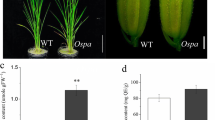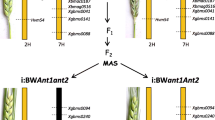Abstract
Pigmentation in rice grains is an important quality parameter. Purple-coloured rice (Oryza sativa L.) indicates the presence of high anthocyanin with benefits of antioxidant properties. However, the genetic mechanism of grain colour is not fully understood. Therefore, the study focused on understanding pigmentation in grain pericarp and vegetative parts, and its relationship with blast resistance and enhanced grain yield. Three local cultivars from the northeastern region (NER) of India — Chakhao Poireiton (purple), Mang Meikri (light brown), and Kala Joha (white) — along with high-yielding varieties (HYVs) Shasharang (light brown) and Sahbhagi dhan (white) were used to develop biparental populations. The findings suggested that pigmentation in vegetative tissue was governed by the inter-allelic interaction of several genes. Haplotype analysis revealed that Kala3 complemented Kala4 in enhancing purple pigmentation and that Kala4 is not the only gene responsible for purple colour as evident by the presence of a desired allele for markers RID3 and RID4 (Kala4 locus) in Chakhao Poireiton and Kala Joha irrespective of their pericarp colour, implying the involvement of some other additional, unidentified genes/loci. RID3 and RID4 together with RM15191 (Kala3 locus) could be employed as a reliable marker set for marker-assisted selection (MAS). Pericarp colour was strongly correlated with colour in different vegetative parts, but showed a negative correlation with grain yield. Pb1, reported to be associated with panicle blast resistance, contributed to leaf blast resistance. Transgressive segregants for improved pigmentation and high yield were identified. The selection of lines exhibiting coloured pericarp, high anthocyanin content, aroma, blast resistance, and increased yield compared to their respective HYV parents will be valuable resources in the rice breeding programme.






Similar content being viewed by others
Data availability
The dataset supporting the findings of this article are included within the article.
References
Bhutia KL, Nongbri EL, Sharma TO, Rai M, Tyagi W (2021) A 1.84-Mb region on rice chromosome 2 carrying SPL4, SPL5 and MLO8 genes is associated with higher yield under phosphorus-deficient acidic soil. J Appl Genet 62:207–222
Bhuvaneswari S, Gopala Krishnan S, Bollinedi H, Saha S, Ellur RK, Vinod K, Singh IM, Prakash N, Bhowmick PK, Nagarajan M (2020) Genetic architecture and anthocyanin profiling of aromatic rice from Manipur reveals divergence of Chakhao landraces. Front Genet 11:570731
Chakraborty D, Ray A (2019) Population genetics analyses of North-East Indian indigenous rice landraces revealed divergent history and alternate origin of aroma in aus group. Plant Genet Resour 17:437–447
Challam C, Ghosh T, Rai M, Tyagi W (2015) Allele mining across DREB1A and DREB1B in diverse rice genotypes suggest a highly conserved pathway inducible by low temperature. J Genet 94:231–238
Chen XQ, Nagao N, Itani T, Irifune K (2012) Anti-oxidative analysis, and identification and quantification of anthocyanin pigments in different coloured rice. Food Chem 135:2783–2788
Cui Y, Song BK, Li L-F, Li YL, Huang Z, Caicedo AL, Jia Y, Olsen KM (2016) Little white lies: pericarp colour provides insights into the origins and evolution of Southeast Asian weedy rice. G3 Genes Genom Genet 6:4105–4114
Deng GF, Xu XR, Zhang Y, Li D, Gan RY, Li HB (2013) Phenolic compounds and bioactivities of pigmented rice. Crit Rev Food Sci Nutr 53:296–306
Devi WJ, Vivekananda Y, Uddin A, Laishram JM, Chakraborty S (2020) Morphological markers associated with pericarp colour and its inheritance pattern in black scented rice of Manipur. Trop Plant Res 7:396–402
Doyle JJ, Doyle JL (1990) Isolation of plant DNA from fresh tissues. Focus 12:13–15
Dutta SS, Tyagi W, Pale G, Pohlong J, Aochen C, Pandey A, Pattanayak A, Rai M (2018) Marker–trait association for low-light intensity tolerance in rice genotypes from Eastern India. Mol Genet Genom 293:1493–1506
Furukawa T, Maekawa M, Oki T, Suda I, Iida S, Shimada H, Takamure I, Kadowaki K (2007) The Rc and Rd genes are involved in pro- anthocyanidin synthesis in rice pericarp. Plant J 49:91–102
Geographical Indication Registry No. 602 (2020) Consortium of produces of Chak-Hao (black rice), Manipur, Office of the nodal office, MOVCDNER Agri, Directorate of Agriculture, Sanjenthong, Imphal, Manipur-795001, India facilitated by: Department of Agriculture, Government of Manipur; and North Eastern Regional Agricultural Marketing Corporation limited. https://search.ipindia.gov.in/GIRPublic/Application/Details/602
Hayashi N, Inoue H, Kato T, Funao T, Shirota M, Shimizu T, Kanamori H, Yamane H, Hayano-Saito Y, Matsumoto T, Yano M, Takatsuji H (2010) Durable panicle blast-resistance gene Pb1 encodes an atypical CC-NBS-LRR protein and was generated by acquiring a promoter through local genome duplication. Plant J 64(3):498–510
Idrishi R, Singha S, Rangan L (2023) A study on various factors affecting the pigmented rice value chain of North East India with a focus on black rice. In: Uppaluri RVS, Rangan L (eds) Conservation of biodiversity in the North Eastern States of India. Springer, Singapore, pp 173–184. https://doi.org/10.1007/978-981-99-0945-2-10
Imam J, Alam S, Mandal NP, Variar M, Shukla P (2014) Molecular screening for identification of blast resistance genes in North East and Eastern Indian rice germplasm (Oryza sativa L.) with PCR based makers. Euphytica 196(2):199–211
Ji ZJ, Wang XG, Zeng YX, Ma LY, Li XM, Liu BX, Yang CD (2012) Comparison of physiological and yield traits between purple-and white-pericarp rice using SLs. Breed Sci 62:71–77
Khan GH, Sofi NR, Shikari AB, Wani SH, Khan R, Hussain A, Mohiddin F, Rahimi M, Bhat NA (2021) Stability analysis of quantitative and qualitative traits in heritage rice landrace Zag (red rice) of Kashmir Himalayas. J Cereal Res 13(2):162–170. https://doi.org/10.25174/2582-2675/2021/111848
Kim J, Lee HJ, Jung YJ, Kang KK, Tyagi W, Kovach M, Sweeney M, McCouch S, Cho YG (2017) Functional properties of an alternative, tissue-specific promoter for rice NADPH-dependent dihydroflavonol reductase. PLoS ONE 2(8):e0183722
Kinoshita T, Maekawa M (1986) Inheritance of purple leaf colour found in indica rice: genetical studies on rice plant, XCIV. J Res Fac Agric Hokkaido Univ 62:453–466
Lahkar L, Hazarika G, Tanti B (2020) Proximate composition, physicochemical and antioxidant properties revealed the potentiality of traditional aromatic (Joha) rice as functional food. Vegetos 33:40–51
Lap B, Rai M, Tyagi W (2021) Playing with colours: genetics and regulatory mechanisms for anthocyanin pathway in cereals. Biotechnol Genetic Eng 37:1–29
Li X, Lv X, Wang X, Wang L, Zhang M, Ren M (2018) Effects of abiotic stress on anthocyanin accumulation and grain weight in purple wheat. Crop Pasture Sci 69:1208–1214
Li W, Chern M, Yin J, Wang J, Chen X (2019) Recent advances in broad-spectrum resistance to the rice blast disease. Curr Opin Plant Biol 50:114–120
Lim SH, Ha SH (2013) Marker development for the identification of rice seed colour. Plant Biotechnol Rep 7:391–398
Lim SH, Kim DH, Kim JK, Lee JY, Ha SH (2017) A radish basic helix-loop-helix transcription factor, RsTT8 acts a positive regulator for anthocyanin biosynthesis. Front Plant Sci 8:1917
Lin SY, Ikehashi H (1993) A gamete abortion locus detected by segregation distortion of isozyme locus Est-9 in wide crosses of rice (Oryza sativa L.). Euphytica 67:35–40
Mackill DJ, Bonman JM (1992) Inheritance of blast resistance in near-isogenic lines of rice. Phytopathology 82:746–749
Maeda H, Yamaguchi T, Omoteno M, Takarada T, Fujita K, Murata K, Iyama Y, Kojima Y, Morikawa M, Ozaki H (2014) Genetic dissection of black grain rice by the development of a near isogenic line. Breed Sci 64:134–141
Mahender A, Swain DM, Das G, Subudhi HN, Rao GJN (2012) Molecular analysis of native Manipur rice accessions for resistance against blast. Afr J Biotechnol 11(6):1321–1329
Mbanjo EGN, Kretzschmar T, Jones H, Ereful N, Blanchard C, Boyd LA, Sreenivasulu N (2020) The genetic basis and nutritional benefits of pigmented rice grain. Front Genet 11:229
Nagao S (1951) Genic analysis and linkage relationship of characters in rice. Adv Genet 4:181–212
Oikawa T, Maeda H, Oguchi T, Yamaguchi T, Tanabe N, Ebana K, Yano M, Ebitani T, Izawa T (2015) The birth of a black rice gene and its local spread by introgression. Plant Cell 27:2401–2414
Rahman MM, Lee KE, Kang SG (2015) Studies on the effects of pericarp pigmentation on grain development and yield of black rice. Indian J Genet Plant Breed 75:426–433
Roy SC, Shil P (2020) Assessment of genetic heritability in rice breeding lines based on morphological traits and caryopsis ultrastructure. Sci Rep 10:1–17
Sahu PK, Sao R, Choudhary DK, Thada A, Kumar V, Mondal S, Das BK, Jankuloski L, Sharma D (2022) Advancement in the breeding, biotechnological and genomic tools towards development of durable genetic resistance against the rice blast disease. Plants 11:2386
Sakamoto W, Ohmori T, Kageyama K, Miyazaki C, Saito A, Murata M, Noda K, Maekawa M (2001) The purple leaf (Pl) locus of rice: Plw allele has a complex organization and includes two genes encoding basic helix-loop-helix proteins involved in anthocyanin biosynthesis. Plant Cell Physiol 42:982–991
Shin J, Park E, Choi G (2007) PIF3 regulates anthocyanin biosynthesis in an HY5-dependent manner with both factors directly binding anthocyanin biosynthetic gene promoters in Arabidopsis. Plant J 49:981–994
Sompong R, Siebenhandl-Ehn S, Linsberger-Martin G, Berghofer E (2011) Physicochemical and antioxidative properties of red and black rice varieties from Thailand, China and Sri Lanka. Food Chem 124:132–140
Sweeney MT, Thomson MJ, Pfeil BE, McCouch S (2006) Caught red-handed: Rc encodes a basic helix-loop-helix protein conditioning red pericarp in rice. Plant Cell 18:283–294
Takahashi ME (1957) Analysis on apiculus colour genes essential to anthocyanin colouration rice. J Res Fac Agric Hokkaido Univ 50:266–362
Tyagi W, Rai M, Dohling A (2012) Haplotype analysis for Pup1 locus in rice genotypes of North-Eastern and Eastern India to identify suitable donors tolerant to low phosphorus. SABRAO J Breed Genet 44:398–405
Tyagi W, Yumnam JS, Sen D, Rai M (2020) Root transcriptome reveals efficient cell signaling and energy conservation key to aluminum toxicity tolerance in acidic soil adapted rice genotype. Sci Rep 10:1–14
Wang X, Ji Z, Cai J, Ma L, Li X, Yang C (2009) Construction of near isogenic lines for pericarp colour and evaluation on their near isogenicity in rice. Rice Sci 16:261–266
Yao A, Sharma A, Manpoong C, Devadas V, Monlai S (2022) Performance of selected traditional rice varieties under Namsai conditions of eastern Himalayas. Crop Res 57:223–229
Zhou Z, Robards K, Helliwell S, Blanchard C (2004) The distribution of phenolic acids in rice. Food Chem 87:401–406
Funding
The research work was funded by CPGSAS, CAU (Imphal), Umiam. Financial support to BL was provided by the Joint Council of Scientific and Industrial Research, University Grant Commission (CSIR-UGC), fellowship under the Ministry of Human Resource Development, India (award no. 332070).
Author information
Authors and Affiliations
Contributions
MR conceptualized the experiment, and WT contributed to the experimental design. Experiments were carried out by BL. Analysis was performed by BL, MP, MR and WT. BL wrote the original draft. All authors read and approved the final manuscript.
Corresponding author
Ethics declarations
Competing interests
The authors declare no competing interests.
Additional information
Communicated by Izabela Pawłowicz
Publisher's Note
Springer Nature remains neutral with regard to jurisdictional claims in published maps and institutional affiliations.
Supplementary Information
Below is the link to the electronic supplementary material.
Rights and permissions
Springer Nature or its licensor (e.g. a society or other partner) holds exclusive rights to this article under a publishing agreement with the author(s) or other rightsholder(s); author self-archiving of the accepted manuscript version of this article is solely governed by the terms of such publishing agreement and applicable law.
About this article
Cite this article
Lap, B., Magudeeswari, P., Tyagi, W. et al. Genetic analysis of purple pigmentation in rice seed and vegetative parts — implications on developing high-yielding purple rice (Oryza sativa L.). J Appl Genetics 65, 241–254 (2024). https://doi.org/10.1007/s13353-023-00825-0
Received:
Revised:
Accepted:
Published:
Issue Date:
DOI: https://doi.org/10.1007/s13353-023-00825-0




